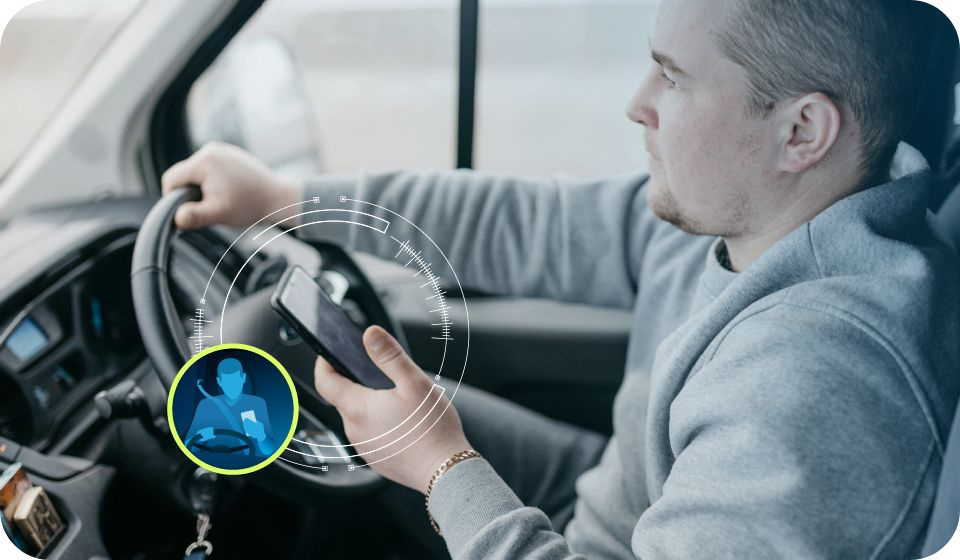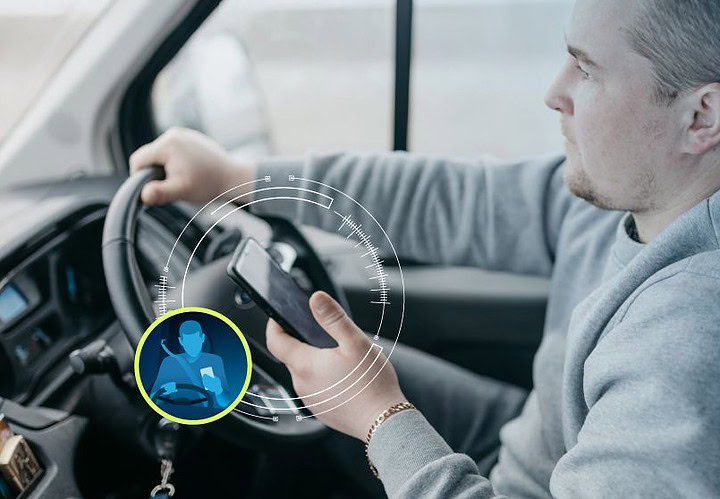AI distraction cameras are increasingly common in the world of transport. In fact, according to a 2023 Berg Insight report, there will be 15 million video telematics systems in use in Europe and North America by 2028.
Designed to boost safety, this innovative technology monitors driver behaviour and provides timely alerts to help prevent accidents. Its importance, especially regarding safety, cannot be overlooked.
But what are AI distraction cameras? How do they work? And what are the key benefits?
In this blog post, we answer these questions, touching on why greater awareness and understanding of AI distraction technology is crucial for transport operators today.

What are AI Distraction Cameras?
AI distraction cameras are advanced devices that enhance road safety by alerting drivers to potentially dangerous behaviours. Powered by artificial intelligence, the set up typically includes driver-facing and forward-facing cameras – or a single camera with multiple lenses – to detect risky driving behaviours.
The driver-facing camera or lens detects risks posed by the driver, such as using a mobile phone, not wearing a seatbelt or eating and drinking while the forward-facing lens monitors the road ahead, capturing video footage that can be used to better understand context in the event of an incident.
Put simply, AI distraction cameras can understand and interpret various activities within the vehicle’s cab and on the road ahead, distinguishing between safe and unsafe driving practices.
How do AI Distraction Cameras work?
AI distraction cameras use machine vision (MV) and artificial intelligence (AI) to scan and evaluate driving patterns to determine potential risks. Paired with advanced algorithms, the camera analyses and identifies specific patterns related to the Driver’s movements.
When risky behaviour is detected, MV and AI can provide in-cab alerts that help empower drivers to change their behaviour reducing the risk of potential collisions.
Video footage and comprehensive dashboards help fleet managers track progress, drive accountability and offer additional training if needed.
Why are AI Distraction Cameras necessary?
Distracted driving poses a significant risk, accounting for nearly 30% of all fatal crashes and 45% of serious injury crashes in Australia.
That’s 45% of all serious incidents! Now, consider the economic impact of these incidents.
From direct costs including vehicle repair or replacement, increased insurance premiums and potential legal fees, to indirect costs such as vehicle downtime, damage to company reputation and – worst case scenario – loss of life, the value of advanced safety technology shouldn’t be underestimated.
By integrating AI distraction cameras, fleets can significantly reduce these risks, leading to safer roads and lower operational costs. It really is that simple.
What driving behaviours can they detect?
AI distraction cameras identify and respond to various high-risk behaviours. And the ability to detect and respond to these behaviours, in near real time, is crucial to prevent accidents helping to ensure road safety.
Here’s some of the behaviours AI distraction cameras can identify:

Driver distraction:
The primary use of AI distraction cameras is to combat driver distraction, which can be split into three distinct categories: Visual Distractions, such as using a mobile phone; Manual Distractions, like changing the radio station; and Cognitive Distractions, including long, in-depth conversations.

Improper seatbelt use:
Wearing a seatbelt is a fundamental safety measure that significantly reduces the risk of injury in accidents. AI distraction cameras can monitor seatbelt usage and alert the driver – or Fleet Manager – if the seatbelt is unfastened when moving. This promotes safety and ensures compliance with traffic laws.

Consumption behaviours:
Eating, drinking, or smoking while driving is a distraction – and AI cameras can recognise these actions using motion detection. When these behaviours are detected, the system can issue warnings, reminding the driver to stop what they’re doing and focus on the road.

Physical distraction:
Searching for something on the passenger seat, adjusting dashboard settings or using a SatNav is referred to as a physical distraction. AI distraction cameras are designed to identify when a driver’s hands leave the steering wheel, which can significantly reduce control of the vehicle.
Beyond these core behaviours, AI distraction cameras can also detect signs of fatigue or drowsiness.
What are the main benefits?
The benefits of AI distraction cameras are endless, and the implementation of this technology not only promotes safety but also helps fleets to adhere to local rules and regulations. Some of the main benefits include:
1. Risk reduction
- Preventing accidents – by monitoring driver behaviour and providing near real-time alerts, AI distraction cameras can help to significantly reduce the likelihood of accidents.
- Enhanced driver awareness – regular feedback from AI technology can help drivers to become more aware of their driving habits and encourage safer practices.
2. Cost control
- Lower insurance premiums – some insurance companies offer lower premiums to fleets that implement advanced safety measures, recognising the reduced risk of costly claims.
- Reduced accident-related costs – costs associated with accidents (such as vehicle repairs, legal fees and compensations) can often be reduced, and operational costs minimised due to less unplanned downtime.
3. Complete compliance
- Regulatory adherence – there are many local laws related to driver behaviour, and AI distraction cameras can help to ensure compliance by monitoring drivers to ensure they adhere to safety standards.
- Improved monitoring & reporting – fleet managers can access detailed reports on driver behaviour, enabling better management and helping adhere to safety requirements.
Overall, AI distraction cameras contribute to a culture of safety and responsibility within the transport industry. By reducing risk factors associated with human error, these systems not only protect fleet assets and employees, but also safeguard the public and contribute to broader safety goals.
This innovative technology represents a significant step forward in the evolution of vehicle safety systems, combining the capabilities of Artificial Intelligence with the practical needs of fleet management and public safety.
Microlise & AI Distraction Cameras
Microlise’s AI distraction cameras are part of a wider range of software solutions that provide comprehensive safety management tools for fleets. These systems integrate with Microlise’s telematics software, offering a seamless experience for monitoring and improving fleet operations.
The multi-camera setup not only focuses on the driver, but also provides peripheral views, ensuring 360-degree coverage which significantly enhances vehicle and road safety.
To find out more about Microlise’s comprehensive safety offering, click the button below.





